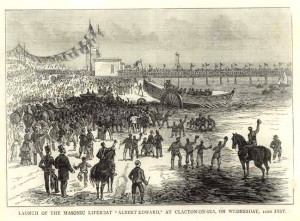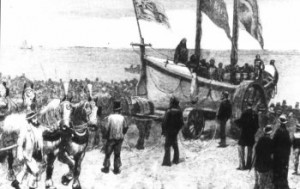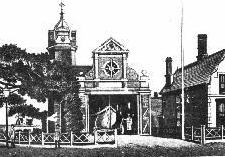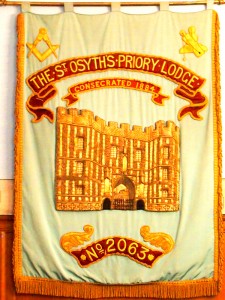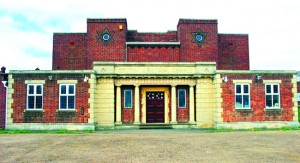The world’s first lifeboat, the “Original”, was built in 1789 at South Shields by freemason Henry Greathead, sometime secretary of St Hilda Lodge. He won a prize for the design from a South Shields committee and also received £1200 from the House of Commons. Within five years, a further 31 boats were built and more than 300 lives were saved. The Royal National Lifeboats Institution was founded in 1824, by the personal efforts and at the considerable expense of Colonel Sir William Hillary, and was titled “The National Institution for the Preservation of Life at Sea”. In 1854 it changed its name to the RNLI, and at the same time started to receive a subsidy from The Board of Trade because voluntary funds were hard to come by. With the subsidy also came Government involvement, but by 1869 when voluntary contributions improved, by agreement the Government withdrew its subsidies.
The United Grand Lodge of England has had a long association with lifeboats since 1869, when an appeal was made for donations to the RNLI and the idea of a Masonic Lifeboat Fund was suggested. The first masonic lifeboat, “The Freemason” was stationed at North Berwick and funded by an appeal launched in “The Freemason”, a masonic magazine published in London. On 1st March 1871 a proposal in Grand Lodge by J R Stebbing, the then Deputy Provincial Grand Master for the Province of Hampshire for a grant of £50 towards the provision of a masonic lifeboat was approved, and the future link with the RNLI was forged.
The oldest surviving lifeboat is the “Zetland”, which was 11th of the 31 Henry Greathead designed boats. It has been fully restored and is exhibited in Redcar, its original home station. The second oldest lifeboat still in existence is the “Tyne”, built by J Oliver of South Shields in 1833 to a design very similar to that of the earlier Greathead lifeboats.
Tynewasfullyrestoredin2009andisoCnadtiLspalkaeyoaftThehrehPoamrkeFstMation,SouthShields. She was operational for more than 60 years and was involved in saving over 1000 lives. Early in the 20th Century, Lord Ravensworth, then Provincial Grand Master for Durham, was presented with a solid silver replica of the Tyne by St Hilda Lodge 240 on behalf of all the South Shields Lodges.
As at 2014, the 14 lifeboats funded by freemasons are: The Freemason (1871-1887), North Berwick; Lady Leigh (1872-1887), Scarborough; Albert Edward (1878-1887), Clacton-on-Sea; Alexandra (1878-1887), Hope Cove; Albert Edward II (1885-1900), Stationed at Clacton-on-Sea; Alexandra II (1887-1900), Hope Cove; City Masonic Club (1897-1918), Poole and Reserve Fleet; Albert Edward III (1901-1932), Clacton-on-Sea; Alexandra III (1903-1934), Hope Cove and Cromer; Duke of Connaught (1921-1951), Peterhead and Reserve Fleet; The Duchess of Kent (1982-2002), Reserve Fleet; Valerie Wilson (2003 onwards ), Newquay; Essex Freemason (2009 onwards), Southend; and Mark Mason (2009 onwards), Milford Haven.
The lifeboat names not surprisingly are also significant. Lady Leigh was the wife of Lord Leigh, Provincial Grand Master for Warwickshire 1852-1905, and the boat was purchased to mark his 20th anniversary as PGM. HRH Albert Edward, Prince of Wales (later Edward VII) was Grand Master 1874-1901. HRH Queen Alexandra was Edward VII’s wife. HRH the Duke of Connaught was Grand Master 1901-1939; interestingly when the Duchess of Kent was launched, the Duke attended and found himself in the unique position of presenting the lifeboat in his capacity as Grand Master to himself as President of the RNLI. The Duchess of Kent was an Arun class lifeboat built in 1982 and held in the Reserve Fleet until 2002 when she was sold to the lifeboat service in Madeira. The Valerie Wilson was founded in memory of the late wife of Leslie Wilson, Deputy Provincial Grand Master for Middlesex.
In 1875, HRH Albert Edward, Prince of Wales, was installed as Grand Master. He was sent on an extended tour of India to represent Queen Victoria, who had become Empress of India. This was a journey not without its hazards and dangers in those days, so when Albert returned, Grand Lodge decided to mark his safe homecoming in some permanent way.
A committee recommended that Grand Lodge provide £4,000 to build two new lifeboat stations, complete with lifeboats, where the RNLI had no presence; Clacton-on-Sea in Essex and Hope Cove in Devon were the chosen sites. The boat at Clacton was named Albert Edward in honour of the Grand Master and Hope Cove’s was named Alexandra after his wife.

